Related Research Articles
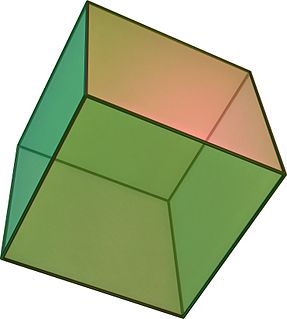
In geometry, a cube is a three-dimensional solid object bounded by six square faces, facets or sides, with three meeting at each vertex.

In geometry, a regular icosahedron is a convex polyhedron with 20 faces, 30 edges and 12 vertices. It is one of the five Platonic solids, and the one with the most faces.

In geometry, the rhombicuboctahedron, or small rhombicuboctahedron, is an Archimedean solid with eight triangular, six square, and twelve rectangular faces. There are 24 identical vertices, with one triangle, one square, and two rectangles meeting at each one. The polyhedron has octahedral symmetry, like the cube and octahedron. Its dual is called the deltoidal icositetrahedron or trapezoidal icositetrahedron, although its faces are not really true trapezoids.

In geometry, a tetrahedron, also known as a triangular pyramid, is a polyhedron composed of four triangular faces, six straight edges, and four vertex corners. The tetrahedron is the simplest of all the ordinary convex polyhedra and the only one that has fewer than 5 faces.
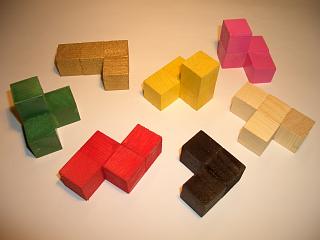
The Soma cube is a solid dissection puzzle invented by Danish polymath Piet Hein in 1933 during a lecture on quantum mechanics conducted by Werner Heisenberg. Its name is alleged to be derived from the fictitious drug soma consumed as a pastime by the establishment in Aldous Huxley's dystopic novel Brave New World.
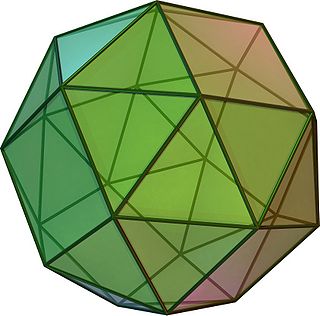
In geometry, the snub cube, or snub cuboctahedron, is an Archimedean solid with 38 faces: 6 squares and 32 equilateral triangles. It has 60 edges and 24 vertices.

In geometry, the 24-cell is the convex regular 4-polytope (four-dimensional analogue of a Platonic solid) with Schläfli symbol {3,4,3}. It is also called C24, or the icositetrachoron, octaplex (short for "octahedral complex"), icosatetrahedroid, octacube, hyper-diamond or polyoctahedron, being constructed of octahedral cells.

In geometry, the rhombic dodecahedron is a convex polyhedron with 12 congruent rhombic faces. It has 24 edges, and 14 vertices of 2 types. It is a Catalan solid, and the dual polyhedron of the cuboctahedron.

A regular icosahedron has 60 rotational symmetries, and a symmetry order of 120 including transformations that combine a reflection and a rotation. Both the regular dodecahedron and the rhombic triacontahedron have the same set of symmetries.

The compound of five tetrahedra is one of the five regular polyhedral compounds. This compound polyhedron is also a stellation of the regular icosahedron. It was first described by Edmund Hess in 1876.

This uniform polyhedron compound is a symmetric arrangement of 6 cubes, considered as square prisms. It can be constructed by superimposing six identical cubes, and then rotating them in pairs about the three axes that pass through the centres of two opposite cubic faces. Each cube is rotated by an equal angle θ.

This uniform polyhedron compound is a symmetric arrangement of 12 tetrahedra, considered as antiprisms. It can be constructed by superimposing six identical copies of the stella octangula, and then rotating them in pairs about the three axes that pass through the centres of two opposite cubic faces. Each stella octangula is rotated by an equal angle θ. Equivalently, a stella octangula may be inscribed within each cube in the compound of six cubes with rotational freedom, which has the same vertices as this compound.
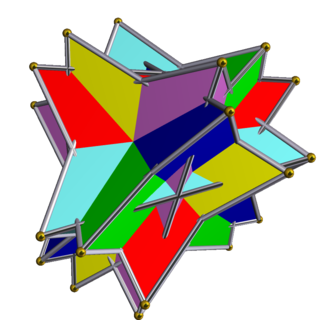
The compound of six tetrahedra with rotational freedom is a uniform polyhedron compound made of a symmetric arrangement of 6 tetrahedra, considered as antiprisms. It can be constructed by superimposing six tetrahedra within a cube, and then rotating them in pairs about the three axes that pass through the centres of two opposite cubic faces. Each tetrahedron is rotated by an equal angle θ. Equivalently, a tetrahedron may be inscribed within each cube in the compound of six cubes with rotational freedom, in such a way as to preserve tetrahedral symmetry.
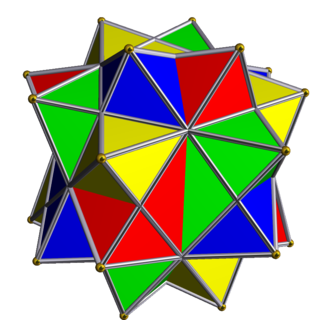
The compound of four octahedra with rotational freedom is a uniform polyhedron compound. It consists in a symmetric arrangement of 4 octahedra, considered as triangular antiprisms. It can be constructed by superimposing four identical octahedra, and then rotating each by an equal angle θ about a separate axis passing through the centres of two opposite octahedral faces, in such a way as to preserve pyritohedral symmetry.

The Void Cube is a 3-D mechanical puzzle similar to a Rubik's Cube, with the notable difference being that the center pieces are missing, which causes the puzzle to resemble a level 1 Menger sponge. The core used on the Rubik's Cube is also absent, creating holes straight through the cube on all three axes. Due to the restricted volume of the puzzle it employs an entirely different structural mechanism from a regular Rubik's Cube, though the possible moves are the same. The Void Cube was invented by Katsuhiko Okamoto. Gentosha Education, in Japan, holds the license to manufacture Void Cubes.
Six-dimensional space is any space that has six dimensions, six degrees of freedom, and that needs six pieces of data, or coordinates, to specify a location in this space. There are an infinite number of these, but those of most interest are simpler ones that model some aspect of the environment. Of particular interest is six-dimensional Euclidean space, in which 6-polytopes and the 5-sphere are constructed. Six-dimensional elliptical space and hyperbolic spaces are also studied, with constant positive and negative curvature.
There is one regular compound of cubes:
The compound of six octahedra has two forms. One form is a symmetric arrangement of 6 octahedra, considered as square bipyramid. It is a dual of a special case of the compound of 6 cubes with rotational freedom.